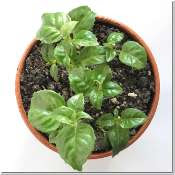With both the Winter Solstice and recent bout of plummeting temperatures behind us, it feels as if spring is around the corner. I have to keep reminding myself winter has barely begun, rising sap or no rising sap. And it's not even as if things were warm outside, not with temperatures running about 3 deg C.
 Encouraged by healthy new fuchsia growth on cuttings taken last October, and - as you shall see shortly - by similar growth in the coffee jar propagator, I could not resist taking some new cuttings, just to see if they will take (yes, I know it's foolish - we usually get a break like this in the winter weather (though usually later, about mid-February)). I had trained myself to resist the said temptation. But this time it somehow feels different. I don't know why. Perhaps it's with being so close to the Solstice.
Encouraged by healthy new fuchsia growth on cuttings taken last October, and - as you shall see shortly - by similar growth in the coffee jar propagator, I could not resist taking some new cuttings, just to see if they will take (yes, I know it's foolish - we usually get a break like this in the winter weather (though usually later, about mid-February)). I had trained myself to resist the said temptation. But this time it somehow feels different. I don't know why. Perhaps it's with being so close to the Solstice.
The lengthening days have not gone unnoticed by the plants (they use phytochrome to detect these, as you will see). If I keep talking like this I'll have sap running in my veins.
 Encouraged by healthy new fuchsia growth on cuttings taken last October, and - as you shall see shortly - by similar growth in the coffee jar propagator, I could not resist taking some new cuttings, just to see if they will take (yes, I know it's foolish - we usually get a break like this in the winter weather (though usually later, about mid-February)). I had trained myself to resist the said temptation. But this time it somehow feels different. I don't know why. Perhaps it's with being so close to the Solstice.
Encouraged by healthy new fuchsia growth on cuttings taken last October, and - as you shall see shortly - by similar growth in the coffee jar propagator, I could not resist taking some new cuttings, just to see if they will take (yes, I know it's foolish - we usually get a break like this in the winter weather (though usually later, about mid-February)). I had trained myself to resist the said temptation. But this time it somehow feels different. I don't know why. Perhaps it's with being so close to the Solstice.The lengthening days have not gone unnoticed by the plants (they use phytochrome to detect these, as you will see). If I keep talking like this I'll have sap running in my veins.










